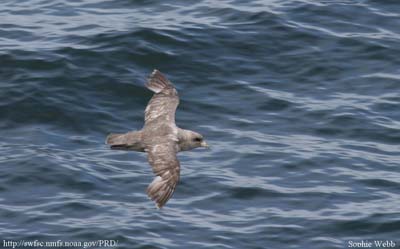Northern Fulmars
Common Name: Northern Fulmars
Scientific Name: Fulmarus glacialis

Description
Northern fulmars are roughly the same size as glaucous-winged gulls, but have a distinctively thick-necked appearance. They range in color from dark blue-grey to a ghostly white, and have a yellowish bill. Fulmars fly with stiff wings and glide in bounding swoops above the wave-tops, making them easy to spot from far away.
Northern fulmars are less attached to the mainland than most of the other seabird species we study. They forage far out to sea, and breed in huge colonies on remote islands. The northern fulmar is one of a very few members of the "tube-nosed" seabird family that breeds in Alaska- all other similar species breed in the Southern Hemisphere. Northern fulmars breed in great numbers on the highest cliff-faces, sometimes with other cliff-nesting species. To defend their nest, fulmars launch an evil-smelling stream of stomach oils from their throats- forcing inquisitve fulmar bioloigsts to wear raingear even on sunny days! They lay only one egg, and it takes most of the summer to fledge their chick. Fulmars can live a very long time- up to 50 years or longer. They forage up to hundreds of miles from the colony, eating a variety of surface species including squid, jellyfish, crustaceans, and small fish. Fulmars are common scavengers of discarded fish thrown overboard by commercial fishing boats- sometimes forming vast chattering groups of thousands of birds.
Range
Breeds from Franz Josef Land south to Brittany in the eastern Atlantic and in Greenland and the eastern Canadian Arctic. There are four small colonies in eastern Newfoundland and southeastern Labrador. Large numbers occur in winter on the Grand Banks and, to a lesser extent, on the Scotian Shelf. A different subspecies breeds in the North Pacific.
Identification Tips
- Length: 18 inches Wingspan: 42 inches
- Sexes similar
- Stocky pelagic bird only coming ashore to breed
- Large shearwater
- Thick yellow bill with tube on top
- Rapid wingbeats
- Glides on stiff wings
Light morph
- White head and underparts
- Gray back, upperwings, rump, and tail
- White "flash" in primaries visible from above
- Mostly white underwings
Gray morph
- Gray head, body, wings, and tail
- Paler underside of flight feathers and upper side of primaries
- Intermediate morph also occurs
Similar species
Gulls flap their wings more slowly and smoothly and lack the tube on top of the bill. Similarly pelagic shearwaters and petrels are slimmer with more distinct patterning.
 Deep Sea Crabs
Deep Sea Crabs